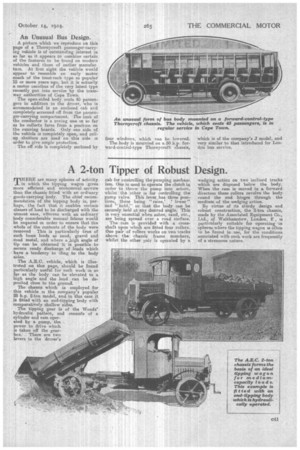DEALING WITH 500 TONS , OF BUS TICKETS ANNUALLY.
Page 24

Page 25

If you've noticed an error in this article please click here to report it so we can fix it.
An Important Phase of the I–G.O.Co.'s Organization.
THE NEW ticket office recently established by the London General Omnibus Co., Ltd., at the Chiswick depot is the largest of its kind in the country. At this centre the work involved in the stoisge, issue, return and checking of tickets is carried out. The -work entailed in the distribution and checking of tickets gives constant employment to over 300 people, for it must be remembered that 28 cwt. or so of tiekets• are :used on " General " buses every day—equivalent to over 500 tons in the course of a year. By, an ingenious arrangement of roller runways the manual labour entailed in dealing with over 8,000 ticket boxes is reduced to a mini/num. These runways distribute the tickets in turn to the various girls dealing with the individual details of checking and replenishing. Including spares, there are over 19,000 ticket boxes in regular use, as well as' a corresponding number of punches.
The replenishing of an ordinary day's
complement of ticket boxes necessitates no fewer than 135,000 waybill entries being made, and, where discrepancies arise between the register of the punch and the conductor's cash sheet, the clippings of the tickets contained inside the punch will Bettie the point in dispute. Each night eight large motorvans set out from the ticket office to the various garages of the company, some journeying so far as Sidcup and Romford. These vans deliver the tickets for the following day, and return with ticket boxes that have been in use.
When it is borne in mind that the London General Omnibus Co., Ltd., run about 150 services, and that on an average each service has about 18 different kinds of tickets in use, some idea will be gained of the systematic organization which is needed in order to deal with the tickets, of which over 3,000,000 are issued daily on " General " vehicles.
Large-capacity Buses Popular.
To judge by the large number of orders recently received by Leyland Motors, Ltd., from municipal authorities, as well as from private owners, the popularity of the large-capacity single-deck bus continues to increase. One of the latest orders • is that received from the Rawtenstall Corporation, which has recently taken delivery of four buses of the type illustrated on this page. This is a 40-seater with a Ribble-type body mounted on a standard S.G 9 chassis.
A modification of the usual side-type bus is exemplified -in this particular vehicle, which is of the half-cab type, this appellation being applied to a body in winch the driver's compartment occupies only the off side of the body front. The seating and general equipment of the interior of the Ravvtenstall bus follows usual practice. The destination indicator is fitted in the interior of the body on the left-hand side, in such a position that it does not inconvenience passengers. The four vehicles are finished in crimson and cream, the lettering in gold standing out in bold relief. The buses are all shod with super-cushion tyres.
An Unusual Bus Design.
A picture which we reproduce on this page of a Thornycroft passenger-carrying vehicle is of outstanding interest in so far as it appears to combine certain of the features to be found on modern vehicles and those of earlier manufac ture. At first sight the vehicle would appear to resemble an early motor coach of the toast-rack type so popular 15 or more years ago, but it is actually a motor omnibus of the very latest type recently put into service by the tram. way authorities of Cape Town.
The open-sided body seats 45 passengers in addition to the driver, who is accommodated in an enclosed cab and completely screened off from the passenger-carrying compartment. The task of the conductor is a roving one in so far as he collects fares from a position on the running boards. Only one side of the vehicle is completely open, and rollup shutters are used on this side :n order to give ample protection. The off side is completely enclosed by four windows, which can be 'lowered_ The body is mounted on a 50 h.p. forward-control-type Thornycroft chassis,
which is of the company's J. model, and very similar to that introduced for London bus service.






























